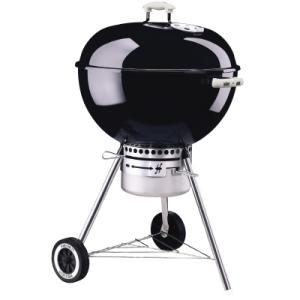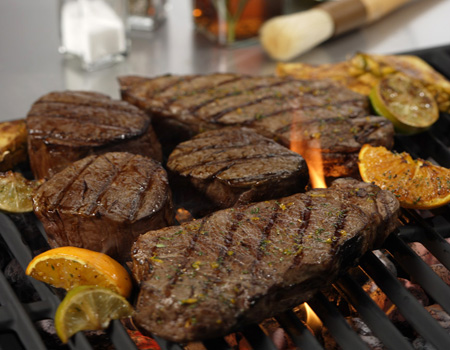Happy day! Super-Cali-Fragilistic Sister-in-Law Chef Sandy weighs in today on the use of a charcoal grill versus gas.
There are some fierce proponents of each. Here, Sandy tells us the ins and outs of using charcoal to cook that gorgeous steak. Enjoy!

Using A Charcoal Grill
Right before Hurricane Ike hit Houston last year, my husband and I decided we needed to have a grill, just in case we lost electricity for a while. We had left our old gas grill behind when we moved, and had planned on replacing it when we got settled in our new home. Well, the day before a hurricane hits is no time to buy a grill, we discovered, and we were not able to find a gas grill anywhere in the Houston area. The only thing we could find was a few bags of charcoal and a camping sized charcoal grill.
Given that there were no other options, we went with the charcoal grill and quickly learned some of the nuances which make this just a little more complicated then firing up a gas grill. I do feel like I have mastered a few tricks which I would like to share with you, whether you are a new user, or someone who may just do the charcoal thing occasionally, like when you are camping or picnicking at a state park.
If you are a long-time charcoal griller, you’ll probably be familiar with all of this. My intended audience is those who have not often had success with charcoal, but would like to give it a try. Gas grills are certainly a convenient option, but if for whatever reason or preference drives you to use a charcoal grill here are some things that might help you have success.
The charcoal grill has two grates — one is intended to support the charcoal at the bottom of the grill, the other is to cook your food on. The lower grate holds the charcoal up slightly from the bottom of the grill so that oxygen can get to the pile of briquettes. Use about 6 total sheets of newspaper, rolled tightly into 2 rolls. Form an X at the bottom of the grill with the 2 rolls of newspaper, and place the bottom grate on top of the newspaper to hold it in place.
Next, form a pyramid of the charcoal, so that it will burn efficiently and not require too much starter fluid. The amount of charcoal you will want to use is limited by the size of the grill, of course, but also should be determined by how much you want to cook. A couple of burgers may only need something like 30 briquettes, but pounds and pounds of steaks and chicken will take longer to cook, therefore you will need a fire that burns longer — plus more briquettes.
Once you have a nice square pyramid (ask your fourth grader!) squirt the pile with the recommended amount of lighter fluid. Don’t forget to read the package. It is usually just a couple-second squirt. Don’t be that guy who squirts half a bottle of lighter fluid onto a pile of burning charcoal – this is dangerous and foolish and stinks! Put the top back on the bottle and put it far from the fire, before you light a match. Light the ends of your paper tubes, which should fairly quickly catch the pile of briquettes on fire.
After about 20 minutes, when the briquettes are covered with ash and the flames have died down, use a fire-proof implement to spread the hot charcoal evenly on the grate. Please use every safety precaution. Sparks can and will fly up. Replace the clean cooking grate on top of the hot charcoal and you are ready to cook.
Enjoy the smokier flavor that charcoal grilling imparts to your food — you may become a convert!
Photo of Weber charcoal grill courtesy of HomeDepot.com.

